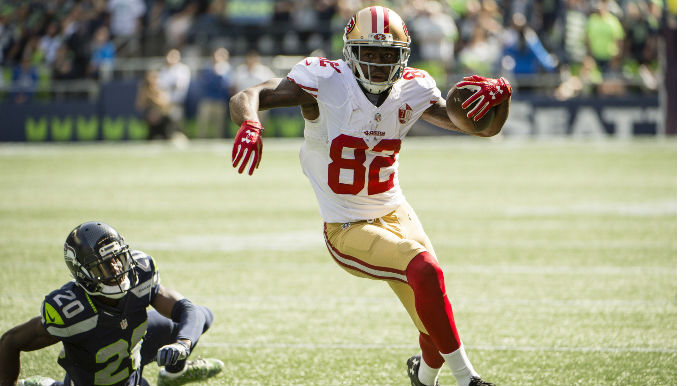Torrey Smith had the strongest voice in the 49ers’ locker room. He held the team together through a painful 2-14 season. When paired with a big-armed quarterback in Baltimore, he was once upon a time one of the best deep threats in the NFL. Smith’s a Walter Payton Man of the Year candidate and a model citizen with high character the new regime is promising to stockpile the organization with.
Ultimately, Kyle Shanahan and John Lynch decided the negatives outweighed the positives. The 49ers released Smith Monday afternoon after just two seasons in the Bay Area.
Those negatives you ask? One piece of information I was able to get from the coaching staff’s internal evaluations: Smith’s speed is not what it was with the Ravens. He’s not a slow wide receiver by any stretch of the imagination, but his speed was no longer effective enough to justify his price.
At the time of his release, Smith was set to be the 49ers’ third-highest paid player. He could latch onto a contender and revive himself — the Philadelphia Eagles were heavily rumored to be a trading partner last November with former GM Trent Baalke. Smith’s next contract will likely not match the $9.5 million a year he was set to fetch in 2017. The free agent market is filled with an assortment of dynamic players. The 49ers are already linked to Alshon Jeffery, Terrelle Pryor and Pierre Garcon.
The 28-year-old was not cut because of his poor production the last two seasons — just 53 combined catches. Shanahan and the offensive coaching staff saw a receiver whose route tree has shrunk, and who was no longer a fit. Whether that was because of the 49ers’ horrendous quarterback situation or not, time will tell. Smith built his name on being able to outrun cornerbacks and safeties deep down the field. Lynch has mentioned multiple times how fast the Atlanta Falcons played under Shanahan. The 49ers are still coveting someone who has that skill set.
“Rarely do I know people’s numbers, at all,” Shanahan said about player evaluations last Wednesday in Indianapolis. “You hear it after you watch it or sometimes you can’t help but people will tell you before. But it has to do with how they play. You can’t do that by looking at numbers or records. You have to watch each play. Just because they make a mistake on a play doesn’t mean it’s their fault. You have to watch their protection. You have to see what the receivers are doing, what the coverage is doing. You have to know the situation in a game and it takes everything into account.”
I asked Smith several times last season if this football team was taking enough chances down the field. The 49ers were second to last in the NFL in pass plays for 40 yards or more (6) — and half of those explosive plays came on screen passes near the line of scrimmage from Vance McDonald and DuJuan Harris. So why didn’t the 49ers utilize Smith’s talent?
“Chip’s offense, he definitely had them called,” Smith told Murph and Mac in February. “We just didn’t execute or take our chances. They were definitely there. It was plenty of opportunities to hit on it, but we didn’t. Which is why I’m all depressed about it (laughter).”
The free agent name I keep hearing the 49ers will pursue the hardest is Garcon. Shanahan originally delivered Garcon from the Colts in 2010 to the Redskins and the move has paid over tenfold. The coaching staff views Garcon as more dependable than Jeffery for a lower cost. But they’ll have competition with the Rams and Redskins. Garcon paired with a middle-round rookie and recently re-signed Jeremy Kerley is a nice upgrade to get the offense up and running in Year 1.
Shanahan hinted what we’ve all seen on the field the last two seasons from San Francisco’s passing attack: There’s not really many difference makers at the position.
“No one in particular,” the head coach said of who stands out on the current roster. “I feel we’ve got a bunch of good players we feel we can compete with, and we know we need to add some, too. We’re going to add as many as we can to help our roster. We also want to have competition, because the more competition we have in OTAs, the more competition you have in training camp …. If you cut some people at the end of training camp who you feel can play in the NFL, then that shows your organization is going in the right direction, and that’s really our goal.”
John Lynch told us last week two words: Stay Awake.


